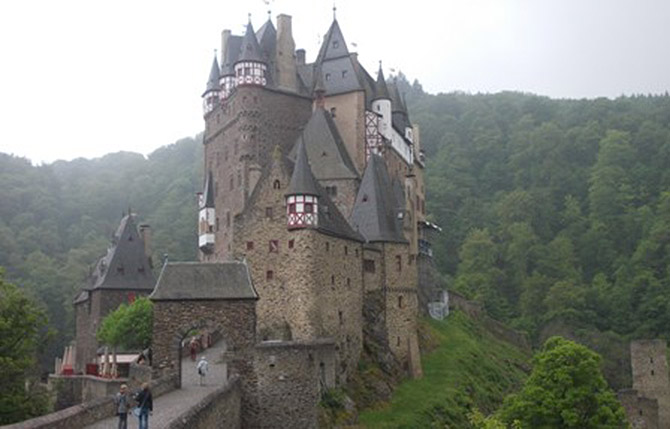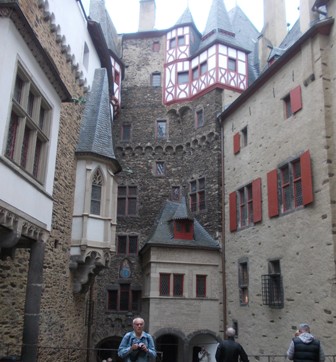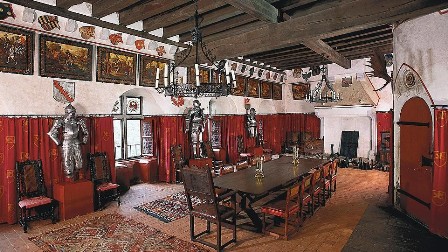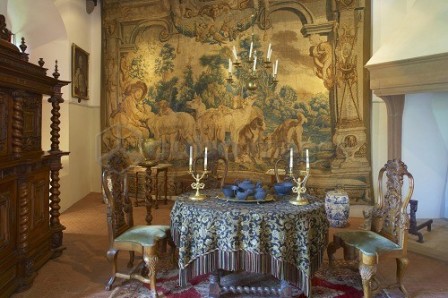The valleys of the Rhine and Moselle rivers have a special place in the obsession with medieval castles. It is interesting that this “Rhine romanticism”, admiration for the charm of the ruined castles of the area, first caught the upper social classes in England, and only a little later this obsession spread among the common people in Germany, where it became the forerunner of the ill-fated German national romanticism.
For the location of those castles, whenever possible, picturesque, wild terrains were chosen, usually on hard-to-reach hilltops, in dense forests or on river bends. The construction was financed by the oldest and richest German noble families, often in locations where their ancestors really had a modest castle or at least a solidly built family home. Among the romantic spendthrifts, the extravagant Bavarian king Ludwig II stood out, and other members of the German high nobility did not resist his challenge.
We must admit that these romantic castles (burgs) are truly architectural masterpieces. The planners, although respecting the infantile taste of those who ordered the project and the nationalistic enthusiasm of the masses, designed very complicated buildings in terms of space and shape and skilfully fitted them into the natural environment. Among other things, when they wanted to, they used all their knowledge and the most modern construction tools to achieve the illusion of authentic half-ruinedness. In the surroundings of the castle, they deliberately built solid and stable, but allegedly “half-demolished” walls, or deliberately formed structurally harmless cracks in the castle walls during construction, and treated them with the most modern means to make them look as old and as dangerous as possible, all so that it would appear that the castle is really several centuries old.
The most architecturally successful of those romantic castles is Burg Hohenzollern, whose construction was financed by the family of powerful Prussian, and later German and Romanian rulers, and which was designed by the Prussian court architect Friedrich August Stüler, consulting, for the sake of authenticity, with the leading fortification engineer of his time.
Despite all the effort and knowledge of their designers, and all the construction skills, the inauthenticity and spontaneity of the creation of those romantic castles is their key flaw. The visitor to such a castle is, of course, fully aware that he is in a counterfeit of an idealized prototype and cannot immerse himself in the false medieval ambience.
So, well, does that mean that the idea people have of a medieval castle is entirely a romantic fiction? Surprisingly, it is not so. The idealized prototype of the medieval castle, whose specific charm later romantic forgeries tried to copy, still exists and it is a real, authentic castle from the 12th century. It is hidden in a dense deciduous forest, about thirty kilometers from the city of Koblenz and is called Burg Eltz. Burg Eltz – original forgery
The valleys of the Rhine and Moselle rivers have a special place in the obsession with medieval castles. It is interesting that this “Rhine romanticism”, admiration for the charm of the ruined castles of the area, first caught the upper social classes in England, and only a little later this obsession spread among the common people in Germany, where it became the forerunner of the ill-fated German national romanticism.

Burg Eltz is located in a paradise forest of untouched natural beauty, in the wider area of the Mosel River. The castle is built on a rock about 70 meters high, around which the river Eltzbach makes a semicircle of 180 degrees, so that it is surrounded by water on three sides. The only approach to the castle is over the stone bridge towards the gate which was easy to defend. The castle basically follows the roughly elliptical shape of the rock on which it is built.
Burg Eltz was built in the 12th century and in its long history it was never conquered or destroyed, so it has survived undamaged into our time. The inevitable reconstruction of the castle, in the nineteenth century, was undertaken by the then owner Count Karl zu Eltz, but unlike many others, he did not want to change its appearance in accordance with the taste of his time, but tried to carefully preserve its authenticity, a decision that , from our perspective, we have to value highly.
From its creation until today, through 33 generations, the owners of the castle are members of the Eltz family, one of the oldest families of high German nobility, who we also know as the rulers of Vukovar during the Habsburg rule. The initiator of the construction was Rudolfus Eltz, a faithful follower of Friedrich Barbarossa, who as a reward for his military merits received a fief with the location for the future castle. His heirs divided into three family branches: Eltz Kempenich, Eltz Rübenach and Eltz Rodendorf, and this significantly affected the internal organization of the castle.
Those three families were the joint owners of the castle, but each one built its own residential building, of approximately equal sizes at the base, and one common part remained. Little by little, in the course of several centuries of construction, until the end of the 15th century, the castle gained a dozen floors, some above ground, some underground. I believe that fans of organic architecture from the 20th century would really like the adaptation of the shape of the underground rooms to the natural rocks that serve as walls.

Spontaneously built residential buildings of different families differ in floor heights, decorations and architectural expression, so the overall impression is enchantingly colorful. The narrowness of space at the base, for each of the residential units, required the construction of circular staircases with unusual, creative exits on different levels. It is an architecture that is created on the spot, no architect can predict it. The interior of the castle
Today’s owner of the castle is called Dr. Karl Graf von und zu Eltz-Kempenich, Faust von Stromberg, is a businessman and lives in Frankfurt, but the residential part of the castle that traditionally belongs to his Kempenich family branch is still used for his family’s residential needs. Parts of the castle that previously belonged to the Rübenach and Rodendorf family branches are accessible to visitors, and recently a group of tourists was there, which the friendly hosts told us was the first to come to them from Serbia.
In all, there are about eighty rooms in the castle, half of which have fireplaces. Many rooms, especially the bedrooms, have toilets, which are flushed automatically with rain water, …when it rains. When there is no rain, there is no washing, you just have to wait for it, but even that is a great luxury considering European medieval standards.
The residential premises of the castle were refined and adapted over the course of several centuries, and this can be traced primarily by the equipment, decoration and arrangement of the rooms. Generally, as the visitor climbs to a higher floor, he encounters more modern rooms. Climbing one floor means moving about a century into the near past.
The living room of the Rübenachs is from the 14th century. The highlights are a Belgian tapestry from the 15th century and a painting by Luke Cranach the Elder, from the early Renaissance, of which the hosts are particularly proud. The room above it from the 15th century is decorated with floral murals from the time of construction.
The kitchen was built in the 15th century, and the authentic dishes are from the 15th-19th century. century. The recesses in the wall, where it was always much colder than the interior of the kitchen, are analogous to today’s refrigerators, and food was stored there.

In the interior of the Knight’s Room, from the 16th century, in which the medieval knight’s armor is displayed, the wealth and power of the noble family can be felt, with the clear aim to impress the guests as much as possible. It is completely appropriate for the purpose of the room, because it was used for negotiations with rivals. The room is decorated, again quite appropriately, with masks of court fools, the only persons who dared to tell the master, “as a joke”, unpleasant truths, and “roses of silence” that warn that nothing agreed upon in it must leave the room.
So, in that room of conspiracy and intrigue, we can say anything to each other, but what is said sub rosa must remain inter nos.
In the room dedicated to the electors from the Eltz family, there is baroque and rococo furniture from the 17th and 18th centuries.

The hunting room raised the pride of the men in the castle. It contains expensive examples of old rifles and hunting trophies from exotic regions: elk and deer horns, bear fur and stuffed heads of killed animals; but also fine pieces of furniture made of carved wooden massif.
On the last floor, in one of the picturesque Bondruč towers, there is the countess’s room for reading and writing, with furniture from the 19th century. “Fairytale Castle”
There is something extremely unusual about the fate of Burg Eltz. While other castles, with more or less success, adapted to the idea that people have about castles from fairy tales, with this one, the opposite seems to have happened. The construction of this castle predated that popular play, moreover, it predated the very notion of a fairy tale. And when fairy tales became popular, the appearance of this castle had a key influence on the illustrators of children’s books and on the subsequent formation of the idea of a medieval knight’s castle.
Today, it is considered that the unintentional originator of that trend was the English painter J.M.W. Turner, who loved Burg Eltz as a motif. So it happened that an extravagant English painter became the forerunner of both French impressionism and German national romanticism, two movements that he himself would never get a real idea of, because they would blossom only after his death. The first of these movements is a significant pride of European civilization, but the second will bring that entire civilization to the very brink of destruction.

